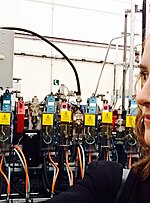Daresbury railway station
Disused railway stations in the Borough of HaltonFormer Birkenhead Railway stationsNorth West England railway station stubsPages with no open date in Infobox stationRailway stations in Great Britain closed in 1952 ... and 2 more
Railway stations in Great Britain opened in 1850Use British English from March 2018

Daresbury railway station was a station in Moore, Cheshire, on the Birkenhead Joint Railway between Runcorn and Warrington. It was named after the village of Daresbury, Cheshire, about a mile away to distinguish it from Moore railway station on the West Coast Main Line. It was open to passengers between 1850 and 1952. It continued to be served by goods trains until full closure in 1965.
Excerpt from the Wikipedia article Daresbury railway station (License: CC BY-SA 3.0, Authors, Images).Daresbury railway station
Runcorn Road,
Geographical coordinates (GPS) Address Nearby Places Show on map
Geographical coordinates (GPS)
| Latitude | Longitude |
|---|---|
| N 53.3533 ° | E -2.635 ° |
Address
Runcorn Road 106
WA4 6UB , Moore
England, United Kingdom
Open on Google Maps








